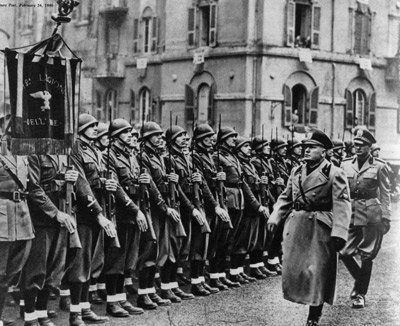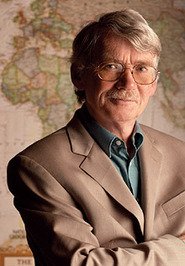
In the early twentieth century, fascism took hold and spread rapidly across Europe. Some states were able to resist the authoritarian nationalist temptations offered through the new movement. While others, succumbed to its temptations and spiraled quickly into fascist states that were characterized by violence. Scholars have offered many explanations as to why some states (the North and North/West) resisted, while others (Central and South/East) embraced the new violent movement.
Michael Mann being a sociologist tends to focus on the sources of power for movements, and as such, he emphasizes the importance of the paramilitary as being essential to the rise of fascism. By doing so he takes the stance that fascism is revolutionary, drawing its support through grass-roots organization and was the result of economic, political, social, and ideology compatibilities. Other scholars such as Robert Paxton take a reactionary stance and instead focus on political factors and actions. Contrary to Mann, Paxton argues that fascism was a reactionary movement that was given traction by the rightist elites to what they thought was capitalism in crisis. Overall, both scholars agree on many points, however, come to different conclusions surrounding the nature of the rise of fascism.
A Look at Robert Paxton

Robert Paxton is an American political scientist and historian who focuses the majority of his studies on fascism within Europe during the 20th century. In 2004 Paxton released his book, “The Anatomy of Fascism” where he attempts to demonstrate what led to fascism being successful in some European countries, and unsuccessful in others. His book places fascism into its historical and political context by carefully laying out the preconditions that caused fascist principles to take hold throughout Europe.
He also puts forth a new perspective on fascism based on what the Fascists did, rather than what they said.[1] Within his book, Paxton is hesitant to quickly define fascism and ultimately builds up to it gradually last chapter where he provides the following definition:
“Fascism may be defined as a form of political behavior marked by obsessive preoccupation with community decline, humiliation or victimhood and by compensatory cults of unity, energy and purity, in which a massed-based party of committed nationalist militants, working in uneasy but effective collaboration with traditional elites, abandons democratic liberties and pursues with redemptive violence and without ethical or legal restraints goals of internal cleansing and external expansion.”[2]
Paxton concludes that fascism took root through conditions caused after World War I and the over-reaction by conservative elites against the socialist and communist left during what was thought to be a crisis of capitalism.
World War I and The Bolshevik Revolutions
Paxton believes that “although precursors can be identified before 1914, adequate space was not available for fascism until after World War I and the Bolshevik Revolution.” [3] To prove this, Paxton first examines the initial fascist movements that were created out of post-World War I conditions, and who their supporters were. In Italy, Fascisms first initial core following consisted of disenfranchised ex-soldiers who served on the front lines during World War I and felt entitled to rule the country they had saved.[4]
This initial constituency that was created through World War I was vital to fascism as they were loyal and willing to dedicate there time for the cause, while also capable of enacting disciplined violence to outmaneuver their political enemies. However, in Paxton’s view this is not the most important factor for the rise of fascism and so, we must look at other causes such as the Bolshevik Revolution.
Paxton argues that fascism was a direct, or reactionary, response to the Bolshevik revolutions in Eastern Europe. Because of this he insists, “the fascist’s relations with traditional conservative elites are central to any understanding of the phenomena.”[5] To give weight to this statement Paxton places capitalism within its historical context, “it is essential to recall how real the possibility of communist revolution seemed in Italy in 192I and in Germany in I932.” [6] At the time, the Bolshevik revolution’s happening in Europe created insecurities among the conservative elite around the future of capitalism.
Out of fear of losing control to the communist and socialist left, the traditional conservative elite aligned themselves with the fascists in order to defend themselves from the perceived threat of losing property rights and profits. These were concerns were also exasperated among the middle-class. As Paxton makes clear that the only occasions when fascists came to power have been at the invitation of traditional conservatives, as members of coalition governments.[7] Contrary to popular belief, the fascists in fact were not anti-capitalist and their preaching’s of loyalty, duty, order, etc could be aligned with the conservative elite appeals. Thus following the great capitalist crisis, traditional conservatives aligned themselves with fascists, which paved the way for the rise of fascism across Europe
Looking Forward – The Five Stages For Fascism Development
Paxton concludes that fascism is a fluid and dynamic process that could re-appear again in the 21st century. Because of this he advocates the use of his five-stage model for classifying and analyzing conditions for fascism development in states. It is important to note that each stage is not a prerequisite for the next, and not all stages need to occur in order for fascism to take hold, an example of Paxton’s fluid view of fascism. Paxton’s five stages for analyzing the rise of fascism are as follows:
(1) the creation of movements,
(2) the rooting in the political system,
(3) the seizure of power,
(4) the exercising of power, and finally stage,
(5) the long duration during which fascist regimes choose either entropy or radicalizations.
The problem with Paxton's five-stage model, however, is that, as he himself admits, most fascist movements did not complete the five stages.[8] In fact, most did not get past stage one, and it could be argued the most of todays democracies are sitting dormant in the first stage of Paxton’s model, while a select few (Greece) have progressed further.
A Look at Michael Mann

Michael Mann is a distinguished historical sociologist who primarily focuses on the sources of power. In 2004, almost coincidently, he published his book, “Fascists” where he presents a new theory on fascism and how to understand its success in some countries and failure in others. Mann’s book seeks to explain fascism by understanding fascists – who they were, where they came from, what their motivations were, how they rose to power.[9]
Within His book he quickly provides the following definition of fascism: “Fascism is the pursuit of a transcendent and cleansing nation-statism through paramilitarism.” [10] Ultimately, Mann argues that paramilitarism was essential to fascism and was a product of post-World War I conditions in Europe which provided the right ideological, political, social, and economic match to the “crisis’ of modernity”.
World War I and The Formation of Paramilitaries
Mann contends that the creation of a paramilitaries following World War I were vital to the success of fascism. These paramilitaries were forged out World War I and the new “total war” mentality that normalized violence and they were the core first wave of all fascism movements.[11] The initial supporters were young hardened war-veterans who brought military virtues and discipline, comradeship, militarism, and hierarchy, and, “just as there were no class differences at the front, paramilitarism could now transcend class differences.”[12]
As well, once returning home it was apparent the soldiers governments were unwilling to meet their needs and incapable of providing them with gainful employment.[13] The military class had lost complete faith within their old governments and was looking for something that would reflect their ideologies and values. Therefore, as Eastern Europe descended further into ideological, political, social, and economic crisis; paramilitarism groups decided issues not voters or debates.[14]
Mann argues that it was a combination of the “four crises of modernity’ in the ideological, social, political, and economic realm, which allowed the conditions for fascism to flourish. In Mann’s view, Fascism offered plausible solutions to these four problems:
"economic, military, political, and ideological crises of early twentieth century modernity. They propounded plausible solutions to modern capitalism's class struggles and economic crises. They transmitted the values of mass citizen warfare into paramilitarism and aggressive nationalism. They were a product of the transition of dual states toward 'rule by the people,' proposing a less liberal and more 'organic' version of this rule."[15]
Thus, Man views fascism as revolutionary; it grew out of the new citizen military combined with a faltering liberal order along with new thoughts about nationalism and the role of the state, or nation-statism. It is a phenomenon to the twentieth century and, because it was found through the ‘four crisis of modernity’ it is unlikely to re-appear in the same form.
Looking Forward
Ultimately, Mann suggests that fascism was a product of post World War I conditions in Europe and is unlikely to reappear in the same form.[16] However, he cautions: “we must take seriously the chance that fascists might return. If we understand the conditions that generated fascists, we can better understand whether they might return and how we might avoid this.”[17]
Mann believes fascism could rise again throughout the world however because of different crisis’s it could take a different form. To better understand the conditions that created fascism, Mann employs the use of the Ideological, Political, Social, and Economic rubric. It is through this rubric, he argues, that we can understand what causes some countries to slip into fascism and others to resist.
Paxton and Mann Compared
Paxton and Mann both come from very different academic backgrounds. This generally means that which variables are important and what matters, as well as which approaches will be used are going to vary between authors. This shows in how Mann, a sociologist, approaches the topic of fascism when compared to Paxton, a political scientist/historian.
Unlike Paxton, who focuses on what actions, stimulus, or context allowed fascism the space to grow, Mann looks at where fascism got its sources of power and how it was able to appeal to such a variety of different people from all backgrounds. This produces two looks at similar variables, with different conclusions. In line with their approaches, Mann contends that fascism was revolutionary and it is not surprising that he comes to this conclusion when analyzing fascism as a social movement. Paxton on the other hand, contends fascism is reactionary and this conclusion stems from his analysis of elites and their actions.
Both Paxton and Mann’s arguments would greatly improve by incorporating each other’s research methods into their arguments. Mann’s book lacks the historical context that would provide the background to understanding how fascist principles took hold. Paxton does this by examining the intellectual, cultural, and emotional roots of fascism pre-1914.[18] Paxton firmly believes that to understand the fascist movements one must understand its pre-conditions.
However, Paxton’s argument is incomplete as it focuses on “big history,” meaning he emphasizes the roles of major people and events. Mann himself is critical of Paxton’s emphasis on the Bolshevik class and believes that although it was a necessary component to understand the rise of fascism it is not a sufficient explanation.[19] Mann not only looks at the importance of major players but at the various classes within society (middle class, elites, political figures). By Mann looking at many different social groups gives a much larger understanding to why citizens in both Italy and Germany supported the fascist governments By combing Paxton’s and Mann’s research methods would only enhance the study of fascism, creating a much more concise history with less exclusion of important factors.
Both scholars acknowledge the vital role that the formation of paramilitaries out of post-World War I conditions played in the rise of fascism. Where the authors deviate is the emphasis on its importance. To Mann, this was a revolutionary movement that drew its power through grassroots organization. In his view, Europe was undergoing a serious of crisis in a variety of realms to the point that “not votes or debates decided issues, but paramilitarism.”[20] This views fascism as being bottom-up and suggests it would have risen in Europe regardless of support from traditional elites because of the ‘four crises of modernity.’ This sharply contrasts with Paxton whom would allow room for paramilitarisms importance, however views fascism as a top-down process that would not have succeeded without invitation by elites.
Mann and Paxton both offer their own definitions which both have overlapping elements but are centrally divided about which variables are emphasized. Both authors agree that statism, nationalism, unity, authoritarianism, and vigor are essential elements of fascism.[21] Where they deviate is in their emphasis on leadership and violence. To Paxton ‘collaboration with traditional elite’ are central in his definition and without the help of elites fascism would not have flourished. This is unlike Mann whom emphasizes the importance of the paramilitary and the disciplined violence they pursued. Paxton has the better argument. This is because even if fascists were able to capture the state, it is unlikely they would have been able to operate effectively or efficiently without collaboration of those within the government, economy, and military.
Conclusion
Both Robert O. Paxton and Michael Mann offer convincing arguments however, the rise of fascism would not have been possible without help from the traditional elites. Mann asserts in his book, “Fascists” that the rise of fascism was the cause of post-World War I conditions along with the ‘four crises of modernity’. As such, fascism is a revolutionary movement that drew its power through paramilitarism, which was vital to its success. Contrary to Mann, Robert Paxton in his book, “The Anatomy of Fascism”, argues that fascism was the result of post-World War I conditions and the Bolshevik Revolution. As a crisis of capitalism swept across Europe, traditional conservative elites turned to fascism to maintain control. As such, it was an as a reactionary movement and without the political collaboration of the traditional conservative elite Fascism would never have gained power.
Bibliography
Anesi, Chuck. “Fascism: The Ultimate Definition.” Anesi. http://www.anesi.com/Fascism-TheUltimateDefinition.htm .
Haynes, Rebecca. “The Anatomy of Fascism.” Slavonic & East European Review, no. 4 (2006):700-702. https://www.jstor.org/stable/4214377?seq=1#page_scan_tab_contents .
Mann, Michael. Fascists. Cambridge: Cambridge University Press, 2004. http://socioline.ru/files/5/283/mann_michael_-fascists-_2004.pdf
Mann, Michael. The Sources of Social Power. Cambridge: Cambridge University Press, 2012. https://uniteyouthdublin.files.wordpress.com/2015/01/the-sources-of-social-power-michael-mann.pdf
Newsinger, John. “The Anatomy of Fascism.” Class and Race, no. 3 (2005): 89-91. rac.sagepub.com .
Paxton, O. Robert. The Anatomy of Fascism. New York: Vintage Books A Division of Random House, 2004. https://libcom.org/files/Robert%20O.%20Paxton-The%20Anatomy%20of%20Fascism%20%20-Knopf%20(2004).pdf
[1] Robert O. Paxton, The Anatomy of Fascism (New York: Vintage Books A Division of Radom House, 2004), 8.
[2] Ibid, 218.
[3] Ibid, 172
[4] Ibid, 4.
[5] John Newsinger. “The Anatomy of Fascism,” Class and Race, no. 3 (2005): 90, rac.sagepub.com .
[6] Robert O. Paxton, The Anatomy of Fascism (New York: Vintage Books A Division of Random House, 2004), 105.
[7] John Newsinger. “The Anatomy of Fascism,” Class and Race, no. 3 (2005): 90,rac.sagepub.com
[8] Rebecca Haynes, “The Anatomy of Fascism,” Slavonic & East European Review, no. 4 (2006): 701, www.jstor.com .
[9] Michael Mann, Fascists (Cambridge: Cambridge University Press, 2004), 1.
[10] Ibid, 13.
[11] Ibid, 69.
[12] Ibid, 103.
[13] Ibid, 122.
[14] Ibid, 122.
[15] Ibid, 364.
[16] Ibid, Preface.
[17] Ibid, 4.
[18] Robert O. Paxton, The Anatomy of Fascism (New York: Vintage Books A Division of Random House, 2004), 32.
[19] Michael Mann, The Sources of Social Power (Cambridge: Cambridge University Press, 2012), 330.
[20] Michael Mann, Fascists (Cambridge: Cambridge University Press, 2004), 122
[21] Chuck Anesi, “Fascism: The Ultimate Definition,” Anesi, .
Hi! I am a robot. I just upvoted you! I found similar content that readers might be interested in:
https://www.travisjamesblog.com/2016/12/fascism-history-mann-paxton/
Downvoting a post can decrease pending rewards and make it less visible. Common reasons:
Submit